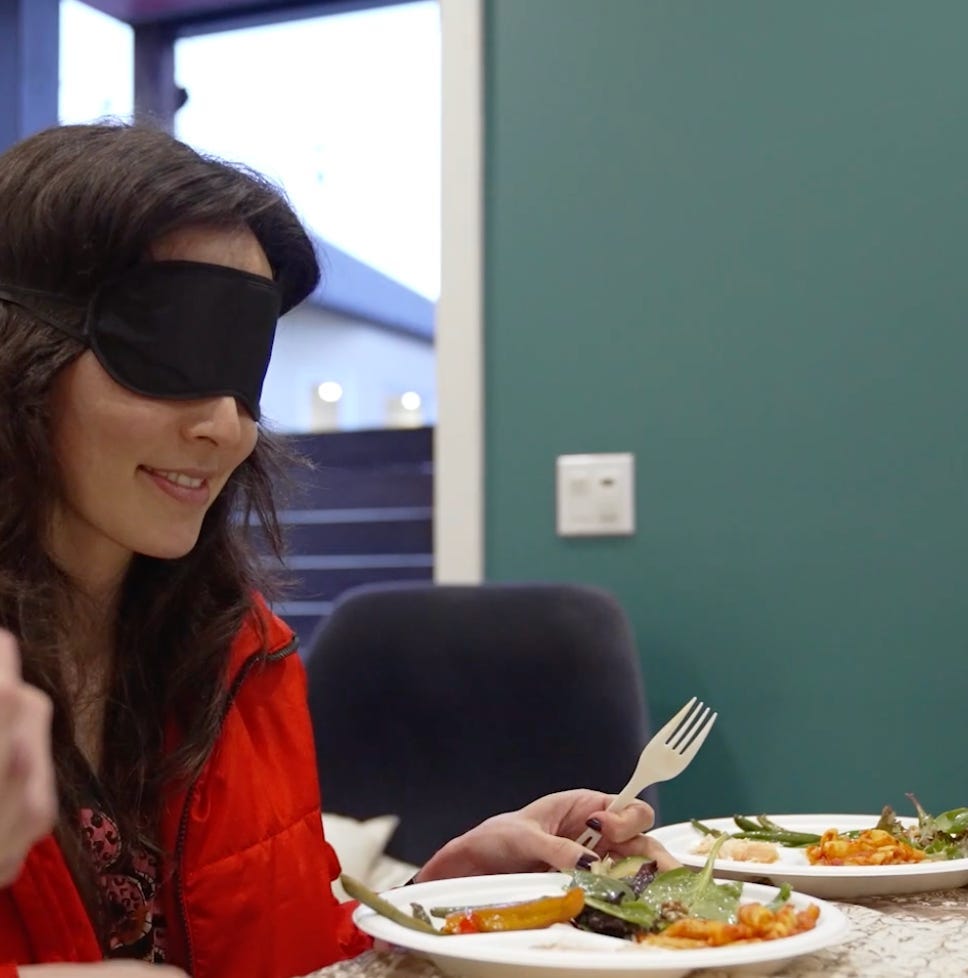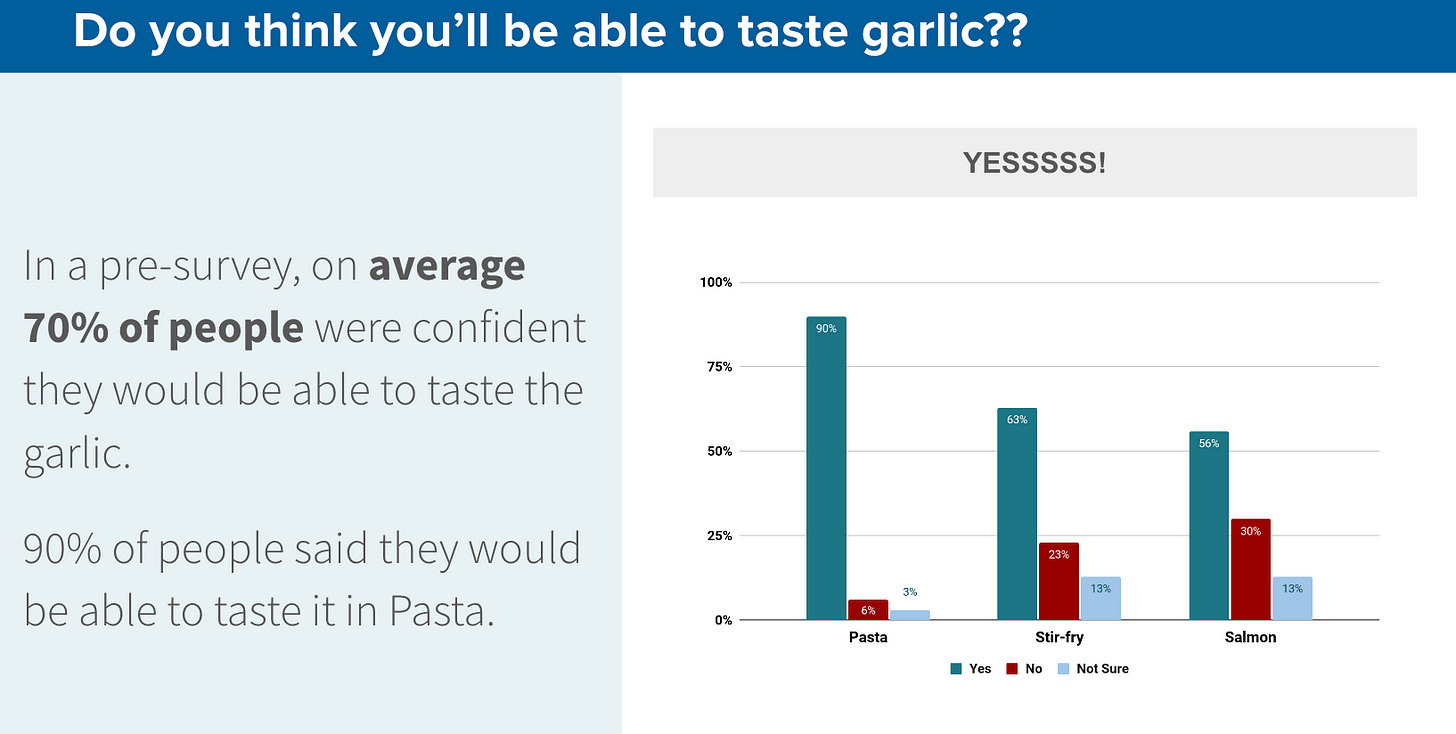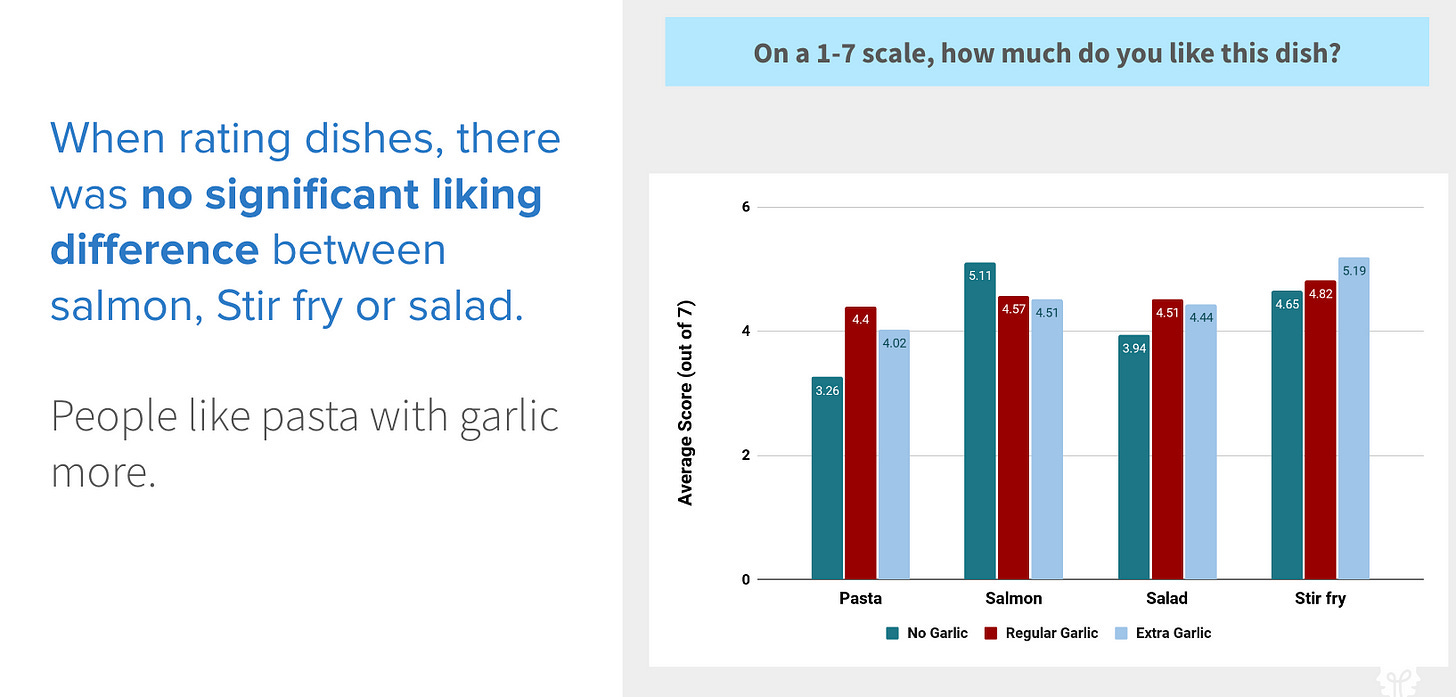Can You Taste the Garlic? Blindfolded Experiment
It's not about the garlic—but it's kinda about the garlic.
I’m a behavioral scientist.
Irrational Labs works with the top companies, solving really big problems. And normally this Substack is about that - I do quippy product teardowns.
But on my birthday, I wanted to prove a point.
Some may say (ok, everyone who was there said…) that it was a silly point to prove. But it was my birthday, so people had to go along with it.
The point is this: Mincing garlic is a waste of time for most recipes.
Why on earth does this matter? The logic goes something like this: Eating out is bad for you. But we eat out a lot because cooking is too damn hard. Cooking is hard because recipes have too many (non-needed) ingredients. And garlic … one of the most common add-ins … garlic I suspected could go for many common dishes.
So here’s a video (thanks, Denoise) and a rigorous-ish lab study on whether people can actually taste garlic in food.
And - to be clear - the event was actually about way more than garlic.
It was about challenging deeply held beliefs.
It was about questioning the status quo.
It was about making the ‘easy' button’ socially acceptable.
It was about testing.
Of course, if you just want to see the garlic results, scroll down. If you want to know why garlic is more than garlic, keep reading.
The smoking gun: Marinating doesn’t matter either
I was first tipped off that recipes overcomplicate things when reading the Test-kitchen analysis of marinating.
Marinating is a way worse offender than garlic. My foodie friends will SWEAR by it. And makes meal prep must harder.
Most recipes call for a 2+ hour marinade. 2 hours. This means that in the morning you’re defrosting the chicken. At 4 pm, you’re marinating it. At 6 pm you’re baking and cooking the side dishes. At 7 pm you eat.
Who has that foresight? That time? That attention? A recipe that tells you to marinate is a recipe that is going to have you ordering a burger and fries on DoorDash instead. And that’s what we want to avoid.
It turns out: 4-hour marinades don’t seep into the meat beyond 1-3 millimeters. The juices don’t go beyond the surface level! This is big. This means the meat only needs a few minutes with the marinade - not 2-4 hours.
Now that we’ve slayed this shibboleth, onto garlic.
Garlic is in a LOT of recipes
Even the “easy” ones make us work for it. Allrecipes has an “easy” salmon recipe that includes mincing garlic and chopping ginger.
This matters - not just to someone’s nightly dinner routine - but to our overall society.
The most popular dish at TGIF Friday’s (the whiskey-glazed burger) is 1110 calories.. Cooking is just healthier - a homecooked cheeseburger is less than half this, or ~460 calories.
If we assume someone who cooks saves a conservative 300 calories - getting people to cook just 2x more a week would shed 9 pounds in a year.
How 'The Garlic Challenge' Worked
36 people arrived. They were blindfolded. And asked to rate 3 dishes - salmon, stir fry, and pasta. Some dishes had no garlic, some had regular amounts of garlic and some had extra garlic.
What happened?
First off, the question is what do people think will happen? In our pre-survey, a whopping 70% of participants were very confident they would be able to taste the difference between dishes with garlic, extra garlic, and those without.
And some did. But a lot didn’t. Most people got a bit confused.
On average people got only 4 of 9 guesses correct.
Let's break it down by dish:
For pasta, 53% of the guesses were correct across all 3 levels of garlic.
In the case of stir fry, the accuracy dropped slightly to 48%.
Things got a bit trickier with salmon, as only 31% of people correctly identified the current level of garlic in the dish.
At this point, garlic lovers are thinking: HELLS NO. How did you prep these dishes? I don’t buy it!! Great. Scroll down for the recipes, but also know that Kristen was 1) not involved in recipes. Expert chef Mike Wang drove this section and 2) She was annoyed by them when she did see them because she wanted something that would be harder for people to detect.
Garlic: Not All It's Chopped Up to Be?
So, how do people get it wrong? There are two ways: Some of us have the ability to taste garlic even when it's not there. 38% of all guesses involved people claiming to taste garlic when, in reality, there was none.
On the flip side, 39% of the time, people couldn't taste the garlic in dishes where it was actually present.
This is the stat that even surprises me. 39% of people couldn’t taste garlic.
And we’re not just wrong when there is a normal amount of garlic, we’re even missing it when there is EXTRA garlic.
Surprisingly, 31% of people failed to taste the garlic in the Extra Garlic Pasta, while 26% couldn't detect it in the Extra Garlic Salmon.
How confident were people in their guesses?
On average, individuals expressed confidence in 56% of their guesses, while they lacked confidence in 29% of their answers. And those that were confident in their guesses? It’s not like they were right more of the time. There was little correlation with actual accuracy.
Now, let's shift our attention to the experts.
Did their expertise give them an edge? Surprisingly, it didn't. Foodies, who we might expect to have a better palate for flavors, got only 39% of their guesses right. Meanwhile, non-foodies fared slightly better, with 53% of their guesses being accurate. So, it seems that being an expert doesn't guarantee superior accuracy in tasting garlic.
We Won't Mince Words
But now for the real question: do we like dishes with garlic more? We asked people to rate the dish on a 7-point scale. And there was no significant difference in ratings for stir fry or salmon on a 7-point scale. People didn’t rate dishes with garlic higher than dishes without. People did rate the pasta with garlic slightly higher.
Because power is low for a low sample and to ensure we were nonbiased with our analysis, we also looked at individual rank order (I may rank pasta a 5.1 and pasta with garlic a 5.2, this isn’t significant but it is a preference), on average, 69% of people expressed a preference for dishes with garlic. 17% either didn't care or preferred the no-garlic options. Salmon stood out - 40% of people liked the salmon without garlic or didn’t have a preference at all.
Peeling Back the Results (Or: A 'Clover' Look)
So what are the big takeaways of our experiment, aside from a little garlic breath? Here's a summary of results:
We’re highly confident we can taste garlic
But ~39% of people were not able to taste garlic in a dish that had garlic.
People on average got about half of their guesses wrong.
Confidence does not correlate with accuracy
Foodies are worse at this game than nonfoodies
On a 7 point scale, there is no significant difference in taste ratings for Salmon and strifry. There is a small bump for pasta. But 69% of people do rank garlic dishes higher than non-garlic.
What It All Means
So, what should you do for cooking?
For pasta lovers, add that garlic. People can taste it when it’s missing and they actually enjoy it. But Pro tip: BUY A SAUCE. We literally used plain tomato sauce as a base. Get Roas and you’re good to go.
When it comes to stir fry, if you're planning to use garlic, don't hold back. Double or triple the recipe. 89% of people detected garlic in the Extra Garlic condition. On the other hand, if you only use a small quantity, they might struggle to detect it.
Now, onto the confusing case of salmon. People's opinions were divided, with 60% enjoying the garlic-infused versions. However, 40% either didn't care or ranked the no-garlic option as their top choice. So, when it comes to salmon, it might be safest to skip the garlic altogether. 55% of people will think it has garlic when it doesn’t.
What should we do as a society?
The whole point of this was to show that cooking today takes time. So how do you get people to do it? Well, the first answer is - you don’t. You just ship people meals.
This is in fact the best way to reduce HbA1c. It works because we make it easy for people (us!) to eat healthy. You don’t have to marinade, you don’t have to mince garlic. You just heat it up.
But this is obviously expensive. And, it turns out a bit unsustainable. People tend to drop out of these programs. Either they are tired of the same meals every night or the meals pile up and go to waste.
But the idea is clever. There is something there. Cooking is too hard. Just look at those 'easy recipes'. To get people to cook more, we need to take a card from the behavioral sciences playbook and make cooking easier. Lets innovate. Or, as many people may now say, let’s instpot.
What should you do personally?
Check yourself.
Our intuitions are not always great - even if we’re confident. Even if we’re experts.
At Irrational Labs, we see this day in and day out. PMs and marketers build products that fail to get the engagement or usage they want - even though everyone thought they would. We need to question our intuition. And realize we’re generally over confident. Foodies were more wrong than novices. And ~40% of people couldn’t taste garlic when it was clearly there.
Want to dive in even more?
Check out the slide deck with the full results.
And if you haven’t watched the video yet - it’s likely a good use of 4 minutes to see people debriefing.
And if you like this weird stuff - subscribe to this Substack or the Irrational Labs newsletter for behavioral economics insights on product development.
The recipes are included in the ppt overview, but here you go, for easy consumption:
Thanks to Mike Wang for his mastermind chef skills. And Deena, Laden and Aarti for their cooking and serving. Thanks to Lena for some fun and games with garlic desserts. Shout out to Sarwari for her rigorous data analysis and Joanna for data entry.
Meet the Collaborators
Mike Wang is not only the master chef for the 2023 Garlic Challenge, but he is also head of Platform at the LongJourneyVC. Before that he was the Head of New Ventures & Learning Experience at Arizona State University. Additionally, Z. Mike Wang was the Global Director, Head of Student Experience at Minerva Project.
Sarwari Das is a data scientist with a passion for behavioral science. As a mixed-methods researcher, she explores human-technology interactions and her expertise lies in applying advanced statistical and causal inference techniques to derive meaningful insights from complex datasets. Having worked with Morningstar, Deloitte, and Humu, Sarwari is driven by intellectual curiosity and seeks problems that allow her to build compelling narratives about data that are nuanced as well as robust in their approach.













I’m a garlic fan. I put it in everything but I will say it’s the pasta sauce where I can actually taste it